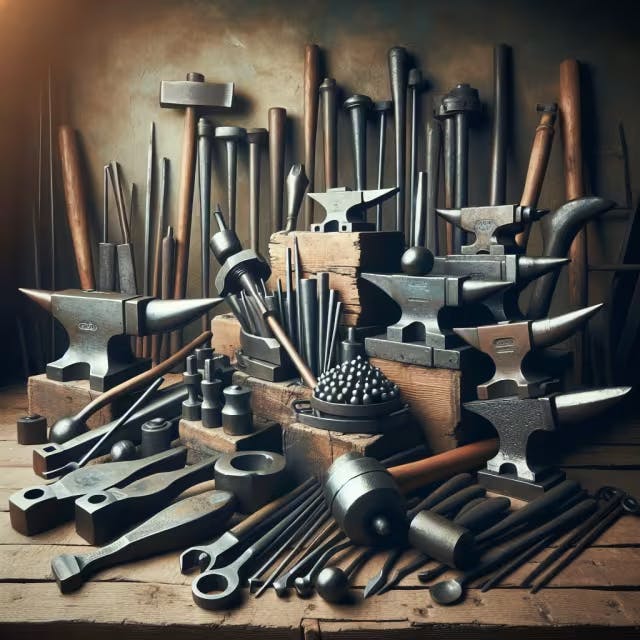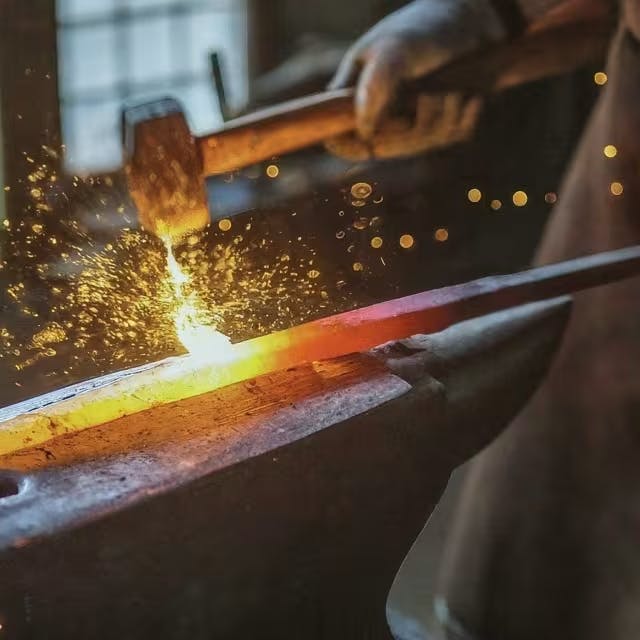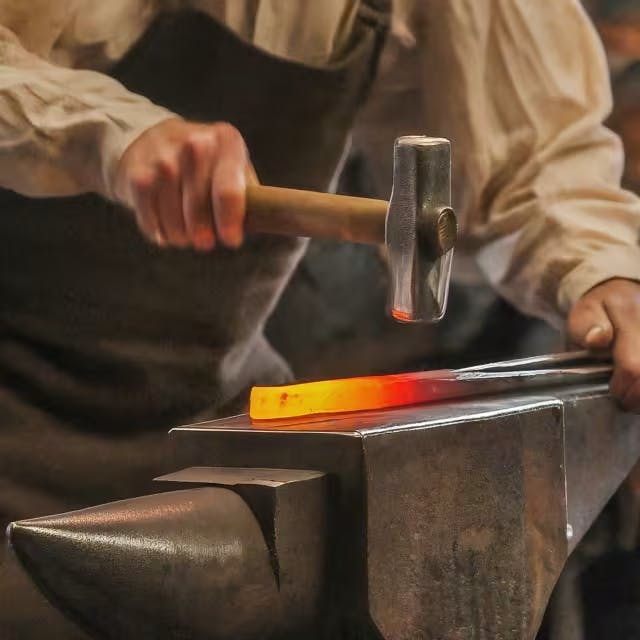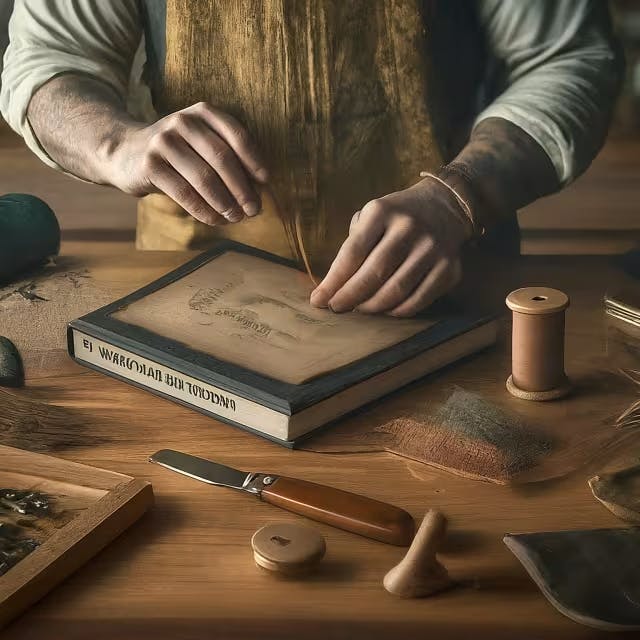Swages and Fullers Explained for Blacksmithing
Abana Chapter
February 11, 2024

Delving into the world of blacksmithing unfolds a treasure trove of knowledge, especially when it comes to essential tools like swages and fullers. With their unique capabilities to shape and enhance metalwork, understanding swages and how they differ yet complement fullers opens up a new perspective on crafting with metal. This exploration into swages and fullers explained for blacksmithing will illuminate their historical significance, functional diversity, and how they contribute to the precise art of crafting swords, decorative pieces, and more, enlightening both seasoned artisans and curious beginners alike.
Key Takeaways
Swages are specialized tools in blacksmithing used primarily to shape and mold metal into various forms, proving essential for detailed work.
Fullers, distinct from swages, are specifically designed for creating grooves, depth, and contours in metal works, adding dimension and texture.
Both swages and fullers play crucial, yet complementary roles in blacksmithing, facilitating a wide range of techniques from shaping to detailing.
Utilizing both swages and fullers enables blacksmiths to craft with higher precision, achieving desired shapes, patterns, and intricate designs in their metalwork.
For beginner blacksmiths, mastering the techniques associated with swages and fullers is vital for developing a versatile skill set and enhancing craftsmanship.
The historical significance of swages and fullers highlights their enduring importance in the evolution of metalworking, from traditional sword making to contemporary decorative pieces.

Understanding Swages in Blacksmithing: What Are They Used For?
Swages play a crucial role in blacksmithing, often misunderstood by those new to the craft. Essentially, swages are specialized tools used to shape metal by creating recesses and contours that would otherwise require more labor-intensive techniques. Their importance was recently underscored by discoveries on Oak Island, where two iron swages speculated to be from the 14th century hint at historical drilling and mining operations. This find suggests the versatility and long-standing utility of swages in metalworking practices throughout history.
A closer look at swages reveals their function in hollowing out or shaping the metal to fit specific designs or functionalities. These tools come in various forms, each suited to different tasks:
Bottom swages fit into an anvil's hardy hole, providing a stationary surface for metal shaping.
Top swages, often used in conjunction with bottom swages, are handheld tools struck with a hammer to mold the metal placed over a bottom swage.
The discovery of ancient swages on Oak Island, examined in detail in an archaeological update, provides a tangible link to the past, showcasing the tool's pivotal role in historical metalwork. This connection underscores the swage's enduring relevance in crafting objects with precision and efficiency, evidencing the tool's evolution but consistent importance in metallurgical development.
For blacksmiths today, understanding and utilizing swages means embracing a tool with deep historical roots and practical applications. Whether used in restorative works, artistic endeavors, or functional metal fabrication, swages embody the blend of tradition and utility that defines blacksmithing.

The Role of Fullers in Blacksmithing: Creating Depth and Contours
Fullers play a pivotal role in shaping and sculpting metal, especially in blacksmithing. These tools are essential for creating grooves or channels in a piece of metal, which not only enhances the aesthetic appeal but also contributes to the structural integrity of the finished product. By compressing the metal's surface, fullers allow blacksmiths to introduce depth and contours with precision.
Usage: Primarily used in forging processes to make concave, cylindrical shapes.
Variations: Available in handheld and power hammer versions to suit different project scales.
To understand the impact of fullers, consider their ability to distribute material and create specific shapes without removing material. This technique is crucial for forming parts that need to remain strong yet lightweight.
For more detailed insights into the applications and techniques, visit this comprehensive guide.
Essential Tools for Blacksmiths: Swages vs. Fullers in Practice
Understanding the roles of swages and fullers in blacksmithing is crucial for beginners and seasoned professionals alike. These tools are pivotal in manipulating metal, but serve different purposes.
Swages: Typically used for shaping metal into specific forms by creating recesses or contours. Swages come in various shapes, allowing for a wide range of applications. They are often used in conjunction with hammers to mold the metal into desired shapes.
Fullers: Compared to swages, fullers are primarily used for spreading metal. They have rounded edges and are employed to make grooves or stretch material. Fullers help in distributing metal along a wider area without cutting through it.
Here's a quick reference table summarizing their main differences:
Feature | Swage | Fuller |
Purpose | Shaping | Spreading |
Edge | Varied Shapes | Rounded |
Used With | Hammers | Hammers or presses |
Application | Contours and Recesses | Grooves and Stretching Material |
For further insights and practical demonstrations on using swages and fullers, exploring online tutorials or workshops can be immensely beneficial. These hand-on experiences not only clarify their distinct roles but also showcase the immense versatility they bring to the field of blacksmithing.

Crafting with Precision: The Benefits of Using Swages and Fullers
Swages and fullers play pivotal roles in blacksmithing, offering precision and efficiency. Swages, typically used for shaping metal, come in various forms, including bottom swages that rest on the anvil and top swages for handheld use. Fullers, on the other hand, are utilized for spreading metal. They come in handy for creating grooves or spreading material in preparation for further shaping.
Swages:
Used for shaping and forming metal into desired contours.
Available in several types for different applications.
Fullers:
Essential for spreading metal and creating grooves.
Aid in preparing metal for further processes.
Utilizing these tools effectively can significantly impact the quality of work produced in blacksmithing projects. Detailed information about using these tools can be found here. Incorporating swages and fullers not only allows for a broader range of designs but also increases work efficiency by minimizing manual effort and shaping time. Therefore, understanding their functions and applications is crucial for anyone involved in blacksmithing.
Swages and Fullers Techniques: Tips for Beginner Blacksmiths
Understanding the purpose and application of swages and fullers is essential for anyone beginning their journey in blacksmithing. These tools are pivotal in manipulating metal to achieve desired shapes and sizes.
Swages, essentially, are tools used for shaping metal in a forge. They come in various forms — from simple handheld tools to complex shapes designed for use with a power hammer. Swages are instrumental when you're aiming to create concave shapes or to fit a piece of metal into a specific form.
Fullers, on the other hand, are used to spread metal. They are often used in conjunction with hammers to stretch the metal, creating grooves or shoulders, which allow for more intricate design and detail in metalwork.
Here are a few beginner tips to help you get started with swages and fullers in blacksmithing:
Start simple: Initially, focus on mastering basic shapes and techniques before moving on to more complex projects.
Temperature is key: Ensure your metal is at the correct temperature for forging; swages and fullers work best with metal that is pliable but not too soft.
Safety first: Always wear appropriate safety gear, including gloves and eye protection, when working with hot metal and tools.
For those looking to dive deeper into the techniques and applications of swages and fullers in blacksmithing, here's a helpful read that explains their roles and uses in greater detail. In conclusion, swages and fullers are indispensable tools in the art of blacksmithing, each serving unique yet complementing purposes. From creating intricate designs to distributing metal evenly, their importance cannot be overstated. Whether you're a novice just starting out or a seasoned professional, mastering the use of swages and fullers is essential for anyone looking to excel in the craft of blacksmithing, blending tradition with precision for exceptional metalwork.
Frequently Asked Questions
What are swages and fullers in blacksmithing and why are they important?
Swages and fullers are essential tools in blacksmithing, each serving a unique purpose in metal manipulation. Swages are used primarily for shaping and forming metal into desired contours, making them indispensable for creating recesses and detailed shapes. They come in various forms, such as bottom and top swages, to suit different tasks. On the other hand, fullers specialize in spreading metal. They're effectively used for creating grooves or stretching material, preparing the metal for further shaping or detailing. The discovery of ancient swages on Oak Island highlights their long-standing importance in metalworking, illustrating how these tools have been pivotal across centuries for their precision and efficiency in crafting durable and intricate metal pieces. Together, swages and fullers provide blacksmiths the ability to forge metal with high precision, allowing for a broad range of creative and functional applications in metalwork.
How do bottom and top swages work together in metal shaping?
Bottom and top swages work together in metal shaping by providing complementary functions that allow for precise manipulation of the metal. The bottom swage is mounted on the anvil's hardy hole and acts as a stationary forming surface, creating a base upon which the metal can be shaped. The top swage is a handheld tool, usually struck with a hammer, used to mold the metal into the desired shape by applying force from above while the metal sits on or in the bottom swage. This combination allows for detailed and specific shapes to be formed in the metal, from creating recesses and contours to achieving complex designs that would be difficult with other tools. Together, these swages offer a highly efficient and versatile method for metal shaping, reflecting a long tradition of metalworking practices.
What are the different types of swages and fullers and their applications?
Swages and fullers are essential tools in blacksmithing with distinct functions for manipulating metal. Swages are used to shape metal by creating recesses or contours, helping in forming metal into specific shapes. These come in various types like bottom swages, which fit into an anvil's hardy hole, and top swages for hand use. Their importance was highlighted by the discovery of ancient swages on Oak Island, indicating their long-standing utility in metalworking. Fullers, in contrast, are used for spreading metal and creating grooves or channels without removing material. They facilitate the introduction of depth and contours, thereby enhancing both the aesthetic appeal and structural integrity of the metalwork. For blacksmiths, these tools not only embody tradition and utility but also enable crafting with precision and efficiency. Whether used in restorative works, artistic endeavors, or functional metal fabrication, understanding the roles and applications of swages and fullers is crucial for producing high-quality work.
How can beginners effectively start using swages and fullers in their projects?
For beginners eager to utilize swages and fullers in their metalworking projects, understanding their distinct functions is crucial. Swages, available in shapes like bottom and top swages, are essential for shaping metal by creating recesses or contours, echoing the traditional craftsmanship seen in historical artifacts. On the other hand, fullers are primarily used to introduce grooves or spread metal, enhancing both the aesthetic appeal and structural integrity of your projects. Here’s how beginners can start:
Learn the basics: Familiarize yourself with the different types and uses of swages and fullers.
Practice: Start with simple projects that allow you to get a feel for how these tools manipulate metal.
Safety First: Always wear protective gear and ensure you're working in a safe environment.
Remember, these tools have been integral to blacksmithing through history, offering a blend of tradition and utility. Starting with these foundational practices will pave the way for mastering more complex techniques in the future.
What are the historical significance and recent discoveries related to swages in metalworking?
Swages have a prominent historical significance in metalworking, dating back to at least the 14th century, as evidenced by recent discoveries on Oak Island. These tools are pivotal for shaping metal into specific forms by creating recesses or contours, which simplifies and enhances the craftsmanship involved in metalworking. Different types of swages, such as bottom and top swages, cater to a variety of shaping tasks, making them versatile and indispensable tools in both historical and contemporary blacksmithing practices. The discovery of ancient swages underscores their enduring relevance and showcases the evolution of metalworking techniques over centuries, highlighting the swage's vital role in the development of metallurgy.


